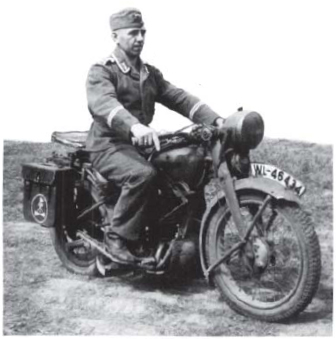
A: BLITZKRIEG, 1939–40
A1: Oberstleutnant, Luft-Nachrichtenregiment 24; Vienna, September 1939
The ‘Höhere Nafü’ of LN-Regt 24, a signals unit of Luftflotte 4, wears the standard officers’ Schirmmütze and Rock – although many favoured more useful ‘bellows’ skirt pockets in the style of the enlisted ranks’ tunic. Pinned to his right breast is the Spanish Cross without swords, signifying a non-combatant veteran of the Legion Condor. The white and black ribbon of the Iron Cross marks his Great War service. The service belt and P38 holster are in the russet leather distinctive of the Luftwaffe.
A2: Major, Kampfgeschwader zbV 1; Western Front, May 1940
This Ju52 pilot, preparing to transport paratroops of 9./Fallschirmjäger Regt 1 from Gütersloh-Rehda airfield to their drop zone in Holland, wears the 1937 version of the K So/34 flight suit with diagonal life vest access zip at the midriff. The series of special sleeve rank insignia for flight clothing, comprising wings and bars, were introduced at the turn of 1935/36. His flare pistol is tucked into his boot, with cartridges carried loose in a knee pocket, and a Walther P38 automatic – unusually – protrudes from the zipped chest pocket. His Fliegermütze bears the standard officer’s distinction of silver piping to the curtain edge. The brown flying boots are of the type made by Hoffmann of Berlin.
A3: Feldwebel, 3 Staffel/Stukageschwader 2 ‘Immelmann’; Battle of Britain, 16 August 1940
Returning from a raid on an RAF fighter airfield, this wireless operator/air gunner’s Ju87B-2 was forced down near Selsey, Sussex. He removes his SWp 734 10-30 life vest, here of transitional manufacture with grey web front straps, revealing details of a rarely seen version of the K So/34 suit with Heisler-Reissverschluss and horizontal fly zip. At his feet lie his discarded LKp S 100 helmet and M295 goggles. See page 38 for seat parachute details.
While most downed aircrew were quickly rounded up by Local Defence Volunteers, police or service personnel, some unfortunates fell into the hands of British housewives armed with kitchen knives and fire-pokers before they could be rescued by the authorities; a few of the more savage beatings proved fatal.

The double silver braid sleeve stripes worn by this Pionier Oberfeldwebel denote his temporary appointment to Hauptfeldwebel (first sergeant), commonly known as ‘Der Spiess’. Broadly equivalent to ‘philistine’, this slang term is difficult to translate succinctly, but alludes to someone who shouts a lot. These insignia of appointment, not rank, should not be confused with rank distinctions for work and protective clothing, upon which the Spiess would wear three white sleeve stripes. The ‘WL’ vehicle registration prefix is abbreviated from Wehrmacht-Luftwaffe.
B: NORTH-WEST EUROPE, 1941–42
B1: Obergefreiter, III Gruppe/Kampfgeschwader 40; Bordeaux-Mérignac, France, summer 1941
This Bombenwart (ordnance armourer) wears the M1935 drill cap, and first pattern unlined black one-piece Arbeitsschutzanzug, illustrating belt, cuff and pocket details, and the double Winkel of his rank on the left sleeve. The central dividing seam was often removed to produce a more practical breast pocket. He has rubber overboots, and has acquired HS 5 o/33 gloves. Note the cardboard tail-fin flutes fitted to the Spreng Cylindrische SC50 (high explosive, general purpose 50kg) bomb. Other principal types included the Spreng Dickwand (high explosive, thick-walled) and Panzerbombe Cylindrische (armour-piercing, general purpose) – in weights of 50kg (110lb), 250kg (550lb), 500kg (1100lb) and 1000kg (1 ton); largest of all was the SC3500 (3½ ton) ‘Max’. KG 40 operated the Do217 and Fw200 ‘Condor’ on anti-shipping duties across the South Atlantic.
B2: Stabsfeldwebel, I Gruppe/Kampfgeschwader 51 ‘Edelweiss’; Melun-Villaroche, France, March 1941
Preparing for an early evening raid over Portsmouth naval dockyard, this Ju88A-1 flight engineer dons a typical assortment of summer and winter clothing. He wears M306 goggles over the sheepskin-lined LKp W 100 helmet, with fitted high-visibility cover in case of ‘ditching’. The communications cable is tucked into the chest pocket, and an Auer HM 15 oxygen mask hangs from the chest loops of his final pattern K So/34 suit. The leg cuffs are fastened over his boots in an effort to secure them during parachute opening shock. At his feet are FW 5 m/33 gloves, the back-type parachute pack, and his 734 10-30 life vest. He hopes that the steel helmet with lining removed will provide protection against AA shell splinters.
B3: Oberleutnant, Seenotstaffel 10; Tromso, Norway, 1942
After a successful rescue off Nordkinnhalvoya on the Barents Sea, this Do24 floatplane observer enjoys a coffee even before removing his chest-type parachute harness and kapok 10-76 B1 life vest, with dye-marker pack attached. Auer M295 goggles are worn over the LKp W 101 helmet. Note the connectors of the electrically wired KW Fl bR/40 suit for heated boots and gloves (dropped onto the navigation equipment case). Sea rescue crews of both sides routinely took pity on each others’ ditched aircrews, and would notify their enemy counterparts of the location via Swiss shipping radio. Rescue aircraft were originally painted white with large red crosses, but received camouflaging colours during 1941 after several were shot down by the Royal Navy – due to their habit of reporting Allied convoys to the Kriegsmarine.
C: RUSSIA & HOME FRONT, 1941–43
C1: Hauptmann, III/Jagdgeschwader 77; Sarabus, Crimea, September 1941
This Bf109F pilot wears uniform typical of the first summer in the USSR. Over Blaumeliertes Hemd and black tie, he sports a commercially acquired leather jacket of French origin; a metal clip at the waistband was more common than a button. Thread loops fitted to the chest accommodated pin-backed awards to avoid piercing the jacket itself, although the awards have been temporarily removed to prevent damaging the life vest. Note matching angles to hip and watch pockets of his finely tailored Stiefelhose. Uniform breeches and trousers were still de rigeur at this date, but the new two-piece Kombination and Tropenüberfallhose became widespread during 1942. The LKp N 101 helmet is worn here with second type Nitsche & Günther splinterproof goggles with elastic strap; the orange-tinted lenses effectively reduced glare. Standard officer’s belt with holstered P08, and single-zip boots, complete his attire.
C2: Hauptgefreiter, Sanitätskompanie; North Compound 3, Stalag Luft 1, Barth, spring 1943
Checking the contents of a Red Cross parcel, this POW camp medic favours the Schirmmütze and Rock, here with dark blue medical Waffenfarbe, although from 1940 these were mainly kept for parade or best dress. Braid loops to the epaulettes mark him as an Unteroffizieranwärter (NCO aspirant). He wears the medical specialist badge on his left forearm, the Eastern Winter 1941/42 medal ribbon in the upper buttonhole, and a black Wound Badge. Situated near the town of Barth in Pomerania on the Baltic coast, Stalag Luft 1 was opened in October 1942 and liberated by the Red Army on 1 May 1945; it held around 9,000 Allied airmen, mostly USAAF, in four compounds.
C3: Unteroffizier, Kampfgruppe zbV 172; Demjansk airlift, Russia, February 1942
Overseeing the balanced loading of his ‘Tante Ju’, this transport crewman is protected by the issue Winterpelzmütze, civilian fur-backed ski mittens, and brown sheepskin KW s/41 suit. Most of the latter were produced in occupied Eastern territories, this example by Knebl & Ditrich of Indija, Croatia. Extreme weather conditions caused endless mechanical problems, but only the very worst prevented take-off. Between February and May the transport units delivered 24,000 tons of supplies to the 100,000 troops trapped in the Demyansk Pocket, as well as airlifting in a further 15,446 men and evacuating 20,093 casualties. The operation cost 262 Ju52s and 385 men, including this unit’s Kommandeur, Major Walter Hammer.
D: NORTH AFRICA & MEDITERRANEAN, 1941–43
D1: Flieger, 1 Batterie/Flak-Regiment 33; Libya, 1941
Among the first Luftwaffe units to arrive in Libya with the Afrikakorps were Flak-Regimenter 6, 18 & 33. Keen to distinguish themselves from Army personnel, these men soon modified their Army-issue Tropenanzug 40 by adding Luftwaffe distinctions – most commonly the red collar patches – although most retained the Heer version of the breast eagle. The red-piped shoulder straps and Tropenmütze required no alteration, although some replaced the cap badge with its Luftwaffe equivalent. This gunner wears a re-issued French Mle 1935 shirt with button-down collar. The Luftwaffe Tropenanzug (Plate E2) replaced this uniform during the following year, but many veterans mixed old Heer items with new Luftwaffe issue. He carries a Munitionskasten (ammunition case) containing two 20-round magazines for the 20mm Flak-38 Kanone, with hand-applied dark yellow paint over the factory-sprayed field-grey.
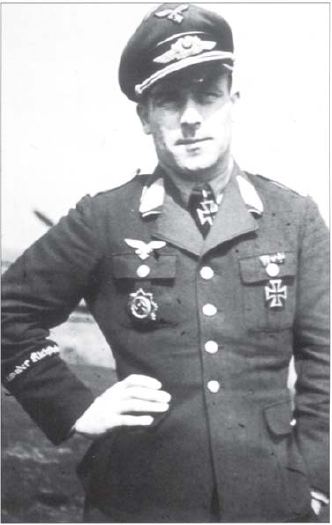
Hauptmann Bruno Stolle, Gruppenkommandeur III./JG 2 (July 1943–February 1944), wears one of 13 commemorative cuff bands bestowed upon distinguished units from 1935. The 33mm blue wool bands were embroidered in Gothic script – here ‘Jagdgeschwader Richthofen’ for JG 2 – in aluminium wire or grey-white thread. The other bands awarded to flight units were ‘Jagdgeschwader Schlageter’ (JG 26); ‘Gesch-wader Horst Wessel’ (ZG 26); ‘Geschwader Immelmann’ (StG 2); ‘Geschwader Hindenburg’ (KG 1); ‘Geschwader General Wever’ (KG 4); ‘Geschwader Boelcke’ (KG 27); ‘Legion Condor’ (KG 53); and ‘Tannenberg’ (NAGr/(H)10). The 1941 War Order of the German Cross, worn on his right pocket, was awarded in silver for repeated outstanding service or in gold for combat exploits deserving more than the Iron Cross 1st Class but not warranting the Ritterkreuz. JG 2 and JG 26, known to Allied airmen as ‘the Abbeville boys’, were the main ‘Kanal Geschwadern’ charged with defending the French and Belgian coasts between 1941 and 1944.
Aircrew badges (Fliegerabzeichen), from 19 January 1935;
All with silver garland and darkened eagle, except Pilot/Observer badge, for which single-seat fighter pilots had to qualify:
(1) Pilot; from 12 August 1935, Pilot/Observer, gilt garland, silver eagle.
(2) Observer/Assistant Observer.
(3) Wireless Operator/Flight Engineer/Air Gunner; from 22 June 1942, Wireless Operator only.
(4) From 22 June 1942, Flight Engineer/Air Gunner Mission clasps (Frontflugspangen), from 30 January 1941: Bronze for 20 operational flights, silver for 60, gold for 110.
(5) Day fighter, heavy fighter & ground attack; from 13 May 1942, day fighter only; from 14 October 1942, with black garland, night interceptor.
(6) From 13 May 1942, heavy fighter & ground attack; from 14 October 1942, with black garland, night intruder.
(7) Bomber, dive-bomber, transport & glider; from 19 November 1941, bomber & dive-bomber only. Illustrated with added pendant for gold clasp categories, introduced 26 June 1942, for 250 flights by recce & night fighter aircrew; 300 by bomber, air-sea rescue & weather; 400 by dive-bomber, heavy fighter & ground attack; 500 by day fighter & transport.
(8) From 12 April 1944, ground attack only. Illustrated with added pendant for all gold clasp categories, introduced 29 April 1944, numbered in 100-flight increments from 200 to 1,800. A unique diamond-studded ‘2,000’ pendant was presented to Oberstleutnant Hans-Ulrich Rudel.
(9) From 19 November 1941, transport & glider only; flights drawing enemy fire counted double toward mission totals. From 23 April 1942, extended to on-board medical & signals personnel.
(10) Recce, air-sea rescue, weather.
Note: For ‘battle badges’ awarded to Luftwaffe personnel – including Flakartillerie – for ground and sea operations, see MAA 365, World War II German Battle Insignia.
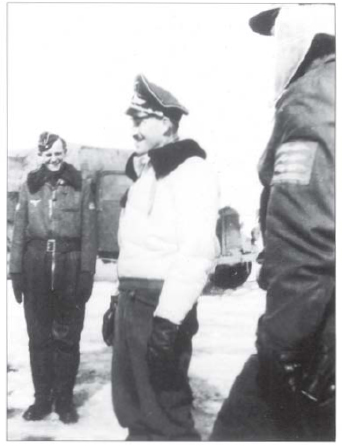
Generalmajor Galland at Ryelbitsii during a tour of fighter units on the Russian Front, winter 1942/43; he wears the pale natural sheepskin KW s/41 jacket. The accompanying Leutnant (left) and Hauptmann wear KW 1/41 suits. Unusually, Galland is not smoking a cigar. As General der Jagdflieger he even officially granted himself permission to smoke on operations; long before he attained this rank his Bf109E was uniquely equipped with an electric lighter, salvaged from a car and fitted by his crew chief, Unteroffizier Gerhard Meyer. Three tobacco companies offered to supply the ace’s 20-a-day habit; he graciously accepted all three. (Private collection)
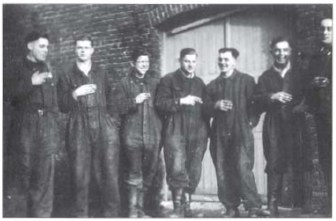
France, 1940: Ground crew wearing the lined dark blue or black Arbeits-schutzanzug, geffütert. The left hand man shows the buckled integral belt of the 1936 suit; the third from left has removed the belt altogether; and the second, fourth and fifth wear 1937 pattern overalls with the belt replaced by internal adjustment tapes. Note pocket details, neckerchiefs, and the use of high rubber boots by the two men at the right.
D2: Leutnant, 2 Staffel/Nahaufklärungsgruppe 14; Libya, May 1942
Returned from a short range reconnaissance mission over Bir Hakeim, this Fi156C-3 ‘Storch’ pilot wears the Tropenschirmmütze with button-on neck curtain, and first type Nitsche & Günther spectacle-style goggles. He has acquired Italian Army ‘stivaletto coloniale’ ankle boots and a bazaar-made tunic, worn over a zip-fronted civilian sweater. Added insignia include a pin-back metal breast eagle from the Sommeranzug. Note the scarce tropical Leibgurt (waist belt) with circular clasp buckle; and the shaped pockets for flare pistol and signal flag on the K So/41 trousers. Tan cloth examples were ideally suited, but far from exclusive to the Mediterranean theatre. The Luftwaffe cuff band ‘AFRIKA’, with grey-white cotton or aluminium-wire lettering on blue wool, was adopted from 25 February 1942. They were seldom worn in theatre, where repeated washing would damage insignia, and were usually reserved for continental uniform – assuming the wearer was fortunate enough to get home leave.
D3: Unterfeldwebel, 1 Staffel/Fernaufklärungs-gruppe 122; Sardinia, February 1943
The combination of temperate and tropical clothing was characteristic of the Mediterranean theatre. This Waffenwart (ordnance specialist) wears the Fliegermütze 35 and Fliegerbluse 40 with tropical shorts rolled fashionably high. The popular and comfortable Laufschuhe are worn with issue grey socks. He reloads ammunition cans for a Bf109F-5 reconnaissance fighter with 500-round belts. It was vital to keep the rounds as clean as possible; any grit in a belt could foul the gun’s feed, and many men were routinely employed in this laborious task – often undertaken on the wing root to avoid contact with the ground. His Gruppe, I./(F)122, flew long-range reconnaissance missions across the Mediterranean. (Errata: his shoulder straps should have Tresse across the ends.)
E: NORTH AFRICA & MEDITERRANEAN, 1942–44
E1: Feldwebel, Pioneer-Kompanie, Jagdgeschwader 27; Qasaba, North Africa, autumn 1942
Supervising construction of a ‘Splitter-Büchse’ (splinter box) three-sided protective pen of rock and sandbags for a Bf109F-2 of III./JG 27, the Feldwebel has donned a wool-knit Schlupfjacke 36 and Übermantel 35 against the evening chill.
Collar patches with laid-on 5mm Tresse sections were specific to NCOs’ overcoats. This veteran ‘Afrikakampfer’, wears whipcord breeches and Tropen-Schnürstiefel boots with high integral strapped gaiters. Protective goggles with ‘Umbral’ 75–95 per cent tinted lenses give protection against sun and dust. Note the large, 1100ml (38fl.oz) Tropenfeldflasche with brown felt cover and webbing cradle3
E2: Gefreiter, Nachschubkompanie 14/Ersatzbataillon XI; Benghazi, 1942
Supply driver Wolf-Dieter Kerszebinsky, who arrived in Africa on 6 May 1942, is seen here bartering for souvenirs in an Arab bazaar. (German servicemen were typically paid on the 10th, 21st and 30th of each month, the Afrikakorps in Italian lire.) He wears Tropenanzug 41 as walking-out dress with Seitengewehr (bayonet), the prescribed sidearm, suspended from a webbing belt with sand-painted buckle. Use of the Tropenhelm was encouraged, though seldom enforced, between 08:00 and 16:00 hours when the sun was at its fiercest. According to Wehrmacht regulations, his camera is carried over the left shoulder when in public. Due to tropical insignia shortages he wears a continental Winkel and field-made Schulterklappen. Kerszebinsky received the Italian-German commemorative medal for Africa on 1 September 1942; was promoted to Obergefreiter on 1 May 1943; and one week later received the Iron Cross 2nd Class which was awarded as general issue upon surrender of the Afrikakorps. All had earned it.
E3: Leutnant, 5 Staffel/Jagdgeschwader 4; Ferrara, Italy, 1944
Stationed north-east of Bologna, this Fw190 pilot wears a well-shaped Sommermütze, a popular affectation in this climate, and displays the Knight’s Cross with Oakleaves without the regulation necktie. From a previous victory against a ‘Dicke Auto’ (‘fat car’ – heavy bomber) he has acquired the prized USAAF A2 flyers’ jacket, now adorned with his own shoulder boards. This is worn with tropical shorts, issue Tropen-Schnürschuhe and rolled white socks. A signalling mirror in its cloth cover is chained to his 10-30 B1 life vest, and a dye-marker pouch is tied to the waist strap. The mesh-topped Netzkopfhaube flight helmet was widely used in this theatre.
F: NORTHERN EUROPE, 1942–44
F1: Unteroffizier, 2 Staffel/Kampfgeschwader 200; Berlin-Finow, summer 1944
A ‘Schwarze’ prepares to re-spray a newly repaired Consolidated B-24J ‘Liberator’. Activated from 20 February 1944, KG 200 was a special unit equipped with captured Allied aircraft for evaluation, fighter training, and some clandestine operations such as the dropping of agents. German-crewed B-17s and B-24s occasionally tagged onto USAAF formations posing as ‘stragglers’, to signal altitude, speed and course estimates to Flak batteries.
Partial Kragentresse on the collar points of his faded black Drillichbluse 35 is the only suggestion of rank. The separate cockade fitted to the Einheitsfliegermütze 43 tended to be obscured by its front flaps, and from early 1944 a new one-piece badge combined a smaller eagle and cockade on a trapezoidal backing.
F2: Oberleutnant, Ergänzungs Zerstörergruppe; Deblin-Irena, Poland, summer 1942
This Bf1 10E-1 instructor replenishes his stock of survival equipment carried in the versatile K So/41 flight trousers. In addition to the signal cartridges visible here, four could be housed in vertical dividers inside the left pocket, and two more in elastic loops under the flap of the right pocket. Cloth or steel anchoring loops were provided inside each knee pocket for cord equipment lanyards, one of which secures a 26.65mm Walther flare pistol to the integral holster. Yet more cartridges are carried in a Taille-Riemen, with longer types stored at the hips for the sake of comfort while seated. The jacket displays shoulder boards, Iron Cross 1st Class, and an embroidered cloth version of the Pilot/Observer’s qualification badge. His Fliegerchronograph, on a lime green wrist strap, was made by Hanhart of Schwenningen-am-Neckar.
F3: Fähnrich, II Gruppe/ Zerstörergeschwader 76; Seerappen, East Prussia, autumn 1944
This keen young ‘Nachwuchs’ (‘new growth’, late war slang for a replacement pilot) on an Me410 squadron is equipped with the LKp N 101 helmet with two-strap oxygen mask fittings, and third type Nitsche & Günther Splitterschutzbrille with folding frames. He wears the jacket from a KW 1/41 suit (with Swiss-made Ri-Ri plastic and steel zips), and trousers from the KW FI bR/41 suit with ceramic central buttons added to knee pocket flaps. Although it could preclude use with the aircraft’s electrical circuit, such mismatches of wired and unwired items were commonplace. Note the soft orange rubber soles to his flying boots, and Ärmband-kompass 39 typically strapped to the 10-30 B2 life vest mouth tube.
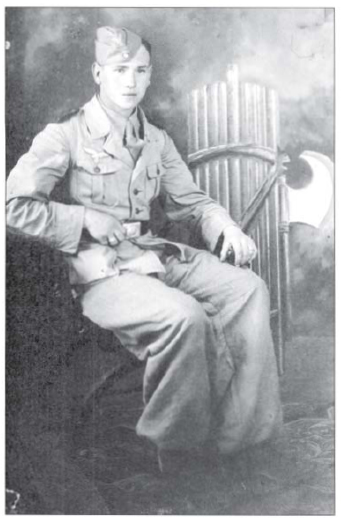
Benghazi, Libya, 15 January 1942: a colonial Italian photographer made this portrait of Flieger Walter Schifer, wearing the smart and practical Tropenanzug with shafted boots, brown leather belt and K98k bayonet: cf Plate E2. His use of grey-blue wool shoulder straps from the continental uniform is indicative of the shortages that plagued the Afrikakorps. The tropical breast eagle applied during tunic manufacture was occasionally replaced with the more visible woollen variety. German servicemen often carried spare cloth insignia among their personal kit.
G: EASTERN FRONT, 1943–45
G1: Flieger, 3 Staffel/Kampfgeschwader zbV 1; medical evacuation, Stalingrad, winter 1942/43
After off-loading desperately needed supplies at Pitomnik just outside Stalingrad, a ‘Sanitäts-Ju’ is hurriedly packed with as many casualties as possible for evacuation to Salk airfield. This assisting mechanic wears an M1937 blue denim one-piece lined working overall, and the awkward wooden-soled Filzschuhe over standard Schaftstiefel. In cold weather the wool Fliegermütze usually replaced the cotton drill cap, and is worn here over the wool-rayon toque. Braving the bitter conditions, it was common for aircrew to shed layers of heavy flight gear in an attempt to warm a few of their freezing casualties.
G2: Oberfeldwebel, II Gruppe/Schlachtgeschwader 2; Bögönd, Hungary, December 1944
Although rare by this date, the bulky KW l/33 suit remained popular with some for its warmth. The blue web belt and multi-panel boots are signs of late war economies. His clothing is completed by FW 5 m/33 gloves, and the Luftwaffe Bergmütze 38 – which was far from exclusive to Luftwaffe mountain service units. A carefully arranged Patronengurt is (unusually) worn around each ankle rather than the upper shins. When all five connecting eyes of the parachute harness were clicked home, the safety clip suspended from the right shoulder strap was snapped into a slot in the buckle housing, preventing accidental release. Removal of the clip, followed by a 90-degree clockwise turn and a sharp blow to the disc, immediately disengaged the connecting eyes and the harness fell away.
G3: Stabsgefreiter, Feldflugplatz-Abwehr; Mamaia, Romania, January 1945
Positioned to defend the north-eastern approaches to the base of II./ZG 1 and their Ju88A-14s, this man wears just the hood and trousers of the schwere Winteranzug, preferring a less restricting rabbitskin jacket. Felt-topped winter boots with separate toe and heel sections and civilian ‘Winterhilfs’ gloves complete his clothing, which is soiled with grease and carbon from the 8.8cm Flak-37. From September 1939 until the end of the war, all types of Flak-Kanone became increasingly engaged in the direct-fire ground role with great effect – most other nations dismissed the concept as too expensive.
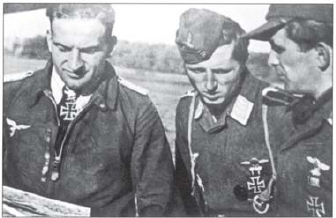
The most decorated German soldier in history: the Stuka pilot Major Hans-Ulrich Rudel of III./SG 2 ‘Immelmann’, uniquely awarded – on 1 January 1945 – the Knight’s Cross with Golden Oakleaves, Swords and Diamonds. He is photographed in Russia in 1944, with Feldwebel Bölling and Unteroffizier Maldinger, both unusually wearing partial Kragentresse on the Fliegerbluse, intended for work wear from 4 September 1942. Bolling’s cloth braces support K So/41 trousers.
During more than 2,500 Ju87 sorties Rudel made 11 aerial ‘kills’, and destroyed 519 tanks and other AFVs (17 in one day), numerous bridges, railway junctions and soft-skinned vehicles, and sank a battleship, a cruiser, a destroyer and over 70 landing barges. Shot-up more than 30 times by artillery fire and wounded five times – once in the shoulder while escaping captivity (followed by a 50km walk back to safety) – he lost his right leg to a direct hit, but returned to combat within six weeks. (Private collection)
H: DEFENCE OF THE REICH, 1944–45
H1: Hauptmann, 12 Staffel/Nacht-jagdgeschwader 1; Leeuwarden, Holland, January 1944
This German-made black leather suit with zip-fastened pockets, worn here with a flamboyant neckerchief, was an expensive choice, and many chose not to adorn it with awards or even the breast eagle; here only the EK I and silver Frontflugspange für Nachtjäger are displayed. Aerial victories were an excuse for celebration, but privately most pilots could identify with their victims, increasing the strain on their nerves. It is remarkable how Luftwaffe airmen endured the accumulating mental pressures of their uniquely extended combat service.
H2: Oberhelferin, 2 Zug/Batterie 13,
14.Flakdivision; Leuna, Germany, October 1944
One of the few front-line postings open to German servicewomen was the Flakscheinwerferdienst (AA searchlight service), formed from 16 October 1943. This Höhenricht-kanonier illustrates standard field dress introduced in mid-1942: Skimütze, three-button Jackett with patch pockets and integral cloth belt, and tapered Keilhosen trousers with buttoned-flap pockets to hips and right rear, commonly tucked into grey socks. The IG Farben synthetic fuel refinery at Leuna, between Berlin and Frankfurt, produced some 75 million gallons (300,000 tons) of aviation grade fuel per year from high-pressure hydrogenisation of lignite coal; every ton of coal produced about 80 gallons. This was the largest of 12 such plants, collectively supplying 85 per cent of Luftwaffe requirements. Inset: Embroidered Zugehörigkeitsabzeichen worn on the Kostümjacke, Jackett and Übermantel. (Errata: the cap eagle is wrongly shown as the reversed type.)
H3: Oberfahnrich, III Gruppe/Kampfgeschwader 76; Karstedt, Germany, 12 March 1945
Most operations in the final months were confined to home territory and the need for survival gear was much reduced. However, the leather KW/41 suit gave vital protection against the volatile J2 synthetic jet fuel – even relatively minor burns could induce rapid, and occasionally fatal blood poisoning. The myriad different uniforms encountered on German soil at this time necessitated quick identification to local inhabitants seeking revenge upon downed Allied ‘Terrorflieger’; the screen-printed cotton armband – here slipped over the pocket flap – served this purpose. A well-worn enlisted ranks’ Schirmmütze is fitted with officers’ chin cords by this aspirant officer. KG 76 was heavily engaged against the Allied Rhine crossings, and this man awaits preparation of his Arado Ar234B-2 jet bomber for an 18-plane level attack on the Ludendorff bridge at Remagen, held by US 9th Armored Division. The raid, and another the next day, proved fruitless. Such operations were considered ‘Himmelfahrtskommando’ (‘heaven-bound’, i.e. suicide missions).
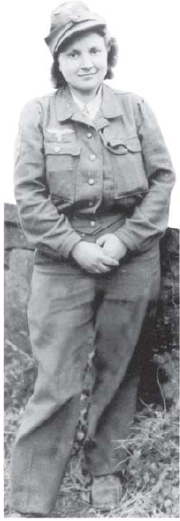
March 1945: captured near Berstadt by the US 4th Armored Division, this Flakhelferin wears the Skimütze without Reichskokarde, and a Jackett echoing the Army’s Feldbluse 44, fitted with the Zugehörigkeitsabzeichen on the right upper sleeve – see Plate H’ Some women alternatively received standard mens’ Fliegerblusen. Ten operators served each 110 volt/24 kilowatt Flakscheinwerfer 150cm searchlight and associated equipment (nine per battery). Under a Scheinwerferführer, they were numbered according to duties: H1, Höhenrichtkanonier (elevation operator); H2, Leuchtkanonier (assistant light operator); H3, Lampenwart (lamp engineer); H4, Beobachter (observer); H5, Sieten-Richtkanonier (traverse operator); H6, Maschinist (mechanical engineer); H7 & H8, Horchgeräten-Arbeiter (sound-detector operators); and H9, Fernsprecher/Fernschreiber (communications operator). (US Army Signal Corps)
3 Collector’s note: the phenol-resin type commonly referred to today as the tropical canteen was simply an economy version of the standard 800ml Feldflasche 31, and apparently saw no service in Africa whatsoever. It was frequently carried by Waffen-SS troops in Holland in 1944 (but this does not imply uniquely SS issue).